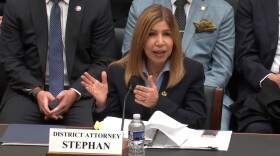A plan to fast-track drilling of thousands of new oil and gas wells over the next 15 years in California’s prime oil patch was being considered Monday by Kern County officials over objections by environmental groups.
The Board of Supervisors was poised to vote on a revised ordinance supported by the influential petroleum industry that creates a blanket environmental impact report to approve as many as 2,700 new wells a year.
The revision was necessary after a state appeals court ruled last year that a 2015 ordinance violated the California Environmental Quality Act by not fully evaluating or disclosing environmental damage that would occur from drilling. New drilling permits were not allowed while the county returned to the drawing board.
County Planning Director Lorelei Oviatt said the plan, which now fills 72 binders of documents, made 87 revisions, including creating larger buffers between homes and wells, muffling noise during drilling and putting a stricter limit on the number of new wells.
The ordinance approved in 2015 would have allowed up to 72,000 wells, but with a lower cap on annual approvals, that number is now reduced to about 43,000 new wells in the 20-year period ending in 2035.
“What we project is the worst case scenario on many issues,” Oviatt said, adding that actual permit numbers in recent years were below the cap.
Petroleum producers, oil workers and industry and business groups spoke in favor of the measure, saying it would support high-paying jobs and produce oil under some of the most stringent environmental laws, instead of relying on dirtier imports.
Environmentalists, several residents and one farmer opposed it, saying the revisions did not address the concerns spelled out by a unanimous 5th District Court of Appeal in Fresno. Many, including several people speaking Spanish, spoke about how more oil drilling would exacerbate the notoriously bad air pollution in the San Joaquin Valley and make asthma cases worse.
Keith Gardiner, a farmer who successfully sued the county, said the new plan still falls short of providing protection for valuable agricultural land, which was one of the court’s findings. He said the county had wasted valuable time and spent millions of dollars supporting its flawed environmental impact report (EIR).
“Whose fault is it?” Gardiner asked. “There are those that will say it’s my fault, and the fault of the environmental groups. Don’t blame us. This is your EIR. The courts have found it’s your fault for not following the law.”
Kern County, about 100 miles (161 kilometers) north of Los Angeles, is the state’s leading fossil fuel producer and also a major agricultural area. About 1 in 7 workers in the county of 900,000 has a job tied to the oil industry.
The vote comes as the industry faces challenges from lawmakers as well as ever-present opposition from environmental groups for creating air and water pollution and significant contributions to climate change.
Gov. Gavin Newsom ordered a ban on the sale of new gas-powered passenger cars and trucks by 2035. New legislation would ban all fracking by 2027, limiting a technique by energy companies to inject water, sand, gravel and chemicals in the ground at high pressure to extract hard-to-reach oil and gas.
The controversy over the ordinance started when the county amended its zoning code in 2015 to allow it to approve new oil and gas extraction permits after a review determined that applications would meet requirements set by a blanket environmental impact report. Environmentalists argued that a one-size-fits-all approach didn’t address different factors that vary by location such as habitat or proximity to neighborhoods.
The ordinance was designed to avoid costly, time-consuming environmental reviews of individual wells and was approved despite “significant, adverse environmental impacts,” the appellate court said.
“The ordinance’s basic purpose is the acceleration of oil and gas development and the economic benefits that might be achieved by that development,” the ruling said. “Its basic purpose is not the protection of the environment.”





